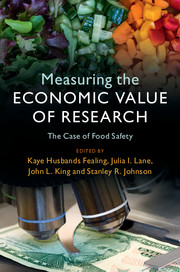31 results
Nine - Policy advisory committees: an operational view
-
-
- Book:
- Policy Analysis in the United States
- Published by:
- Bristol University Press
- Published online:
- 12 April 2022
- Print publication:
- 21 February 2018, pp 173-182
-
- Chapter
- Export citation
Index
-
- Book:
- Measuring the Economic Value of Research
- Published online:
- 15 December 2017
- Print publication:
- 28 December 2017, pp 183-184
-
- Chapter
- Export citation
Contributors
-
- Book:
- Measuring the Economic Value of Research
- Published online:
- 15 December 2017
- Print publication:
- 28 December 2017, pp xiii-xviii
-
- Chapter
- Export citation
Copyright page
-
- Book:
- Measuring the Economic Value of Research
- Published online:
- 15 December 2017
- Print publication:
- 28 December 2017, pp iv-iv
-
- Chapter
- Export citation
1 - Introduction and Motivation
-
-
- Book:
- Measuring the Economic Value of Research
- Published online:
- 15 December 2017
- Print publication:
- 28 December 2017, pp 1-10
-
- Chapter
- Export citation
Figures
-
- Book:
- Measuring the Economic Value of Research
- Published online:
- 15 December 2017
- Print publication:
- 28 December 2017, pp ix-x
-
- Chapter
- Export citation
3 - The Conceptual and Empirical Framework
-
-
- Book:
- Measuring the Economic Value of Research
- Published online:
- 15 December 2017
- Print publication:
- 28 December 2017, pp 51-68
-
- Chapter
- Export citation
Foreword
-
- Book:
- Measuring the Economic Value of Research
- Published online:
- 15 December 2017
- Print publication:
- 28 December 2017, pp xix-xxii
-
- Chapter
- Export citation
5 - The Structure of Research Funding
-
-
- Book:
- Measuring the Economic Value of Research
- Published online:
- 15 December 2017
- Print publication:
- 28 December 2017, pp 85-99
-
- Chapter
- Export citation
Dedication
-
- Book:
- Measuring the Economic Value of Research
- Published online:
- 15 December 2017
- Print publication:
- 28 December 2017, pp v-vi
-
- Chapter
- Export citation
7 - New Insights into Food Safety Research Teams
-
-
- Book:
- Measuring the Economic Value of Research
- Published online:
- 15 December 2017
- Print publication:
- 28 December 2017, pp 113-127
-
- Chapter
- Export citation
Acknowledgments
-
- Book:
- Measuring the Economic Value of Research
- Published online:
- 15 December 2017
- Print publication:
- 28 December 2017, pp xxiii-xxiv
-
- Chapter
- Export citation
4 - Identifying Food Safety–Related Research
-
-
- Book:
- Measuring the Economic Value of Research
- Published online:
- 15 December 2017
- Print publication:
- 28 December 2017, pp 69-84
-
- Chapter
- Export citation
6 - The Food Safety Research Workforce and Economic Outcomes
-
-
- Book:
- Measuring the Economic Value of Research
- Published online:
- 15 December 2017
- Print publication:
- 28 December 2017, pp 100-112
-
- Chapter
- Export citation
Tables
-
- Book:
- Measuring the Economic Value of Research
- Published online:
- 15 December 2017
- Print publication:
- 28 December 2017, pp xi-xii
-
- Chapter
- Export citation
11 - Conclusion
-
-
- Book:
- Measuring the Economic Value of Research
- Published online:
- 15 December 2017
- Print publication:
- 28 December 2017, pp 175-182
-
- Chapter
- Export citation
Contents
-
- Book:
- Measuring the Economic Value of Research
- Published online:
- 15 December 2017
- Print publication:
- 28 December 2017, pp vii-viii
-
- Chapter
- Export citation

Measuring the Economic Value of Research
- The Case of Food Safety
-
- Published online:
- 15 December 2017
- Print publication:
- 28 December 2017
13 - Developments in Data for Economic Research
-
-
- Book:
- Economics without Borders
- Published online:
- 24 March 2017
- Print publication:
- 27 April 2017, pp 568-611
-
- Chapter
-
- You have access
- Open access
- Export citation
Dedication
-
- Book:
- Privacy, Big Data, and the Public Good
- Published online:
- 05 July 2014
- Print publication:
- 09 June 2014, pp v-vi
-
- Chapter
- Export citation

